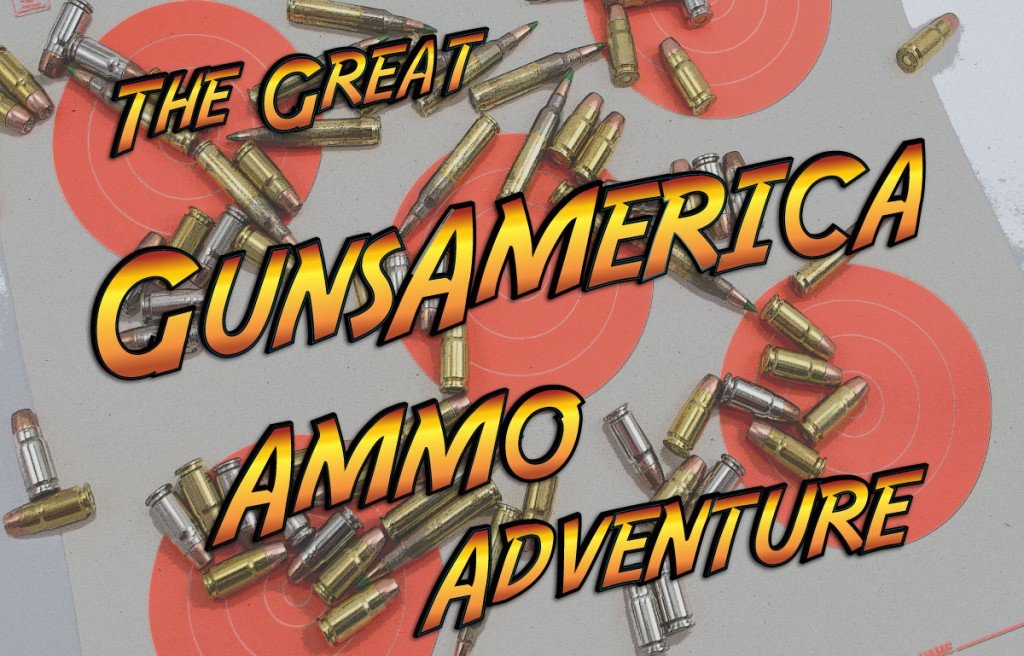
We’re starting a new project here: The Great GunAmerica Ammo Adventure. Each week, we’ll take an in depth look at a specific cartridge. Not a brand, but a specific brand, model, caliber and loading. Ammo performance is a tricky subject, and just because brand “Mega-Doom Blaster Expander” works great in the 9mm +P loading doesn’t mean that the .45 ACP ++++P+++++++ load works properly. With that said, we’ll take an in-depth look at velocity, consistency and performance in ballistic gelatin where appropriate. Want to see your favorite load in an upcoming weekly installment? Let us know in the comments…
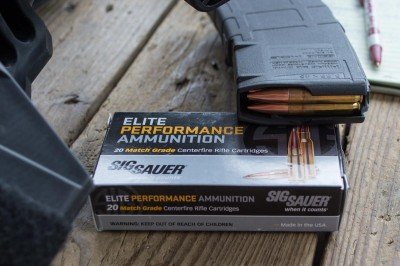 There’s not much that the Sig Sauer folks aren’t making these days, except, perhaps shotguns. I’m guessing that’s only a matter of time. One of the relatively new projects from the Sig Sauer team is a line of premium ammunition. Given the recent launch of the new MCX rifles in 300 Blackout, it follows that one of the first ammo offerings would be in that caliber.
There’s not much that the Sig Sauer folks aren’t making these days, except, perhaps shotguns. I’m guessing that’s only a matter of time. One of the relatively new projects from the Sig Sauer team is a line of premium ammunition. Given the recent launch of the new MCX rifles in 300 Blackout, it follows that one of the first ammo offerings would be in that caliber.
I got my hands on several boxes of the Sig Sauer 300 AAC Blackout Match Grade cartridges. The first 300 Blackout offering from Sig is subsonic and makes use of Sierra’s 220 grain Matchking projectiles. Rated at 1,000 feet per second at the muzzle, it delivers 488 foot-pounds of muzzle energy.
In terms of velocity, the marketing folks at Sig hit the nail on the head. The box is marked 1,000 feet per second at the muzzle. I set up a Shooting Chrony Beta Master chronograph 15 feet down range to check out actual velocity out of two different guns.
First, I shot 10-round strings from a Daniel Defense DDM4v5 300 Blackout rifle with a 16-inch barrel. Since this particular ammo is subsonic, I felt it would be tragic not to use a suppressor, so I mounted a SilencerCo Specwar 762 out front. You wanna guess what the 10-shot average velocity was? You got it, exactly 1,000.0 feet per second. My setup measures to 1/10th feet per second velocity and it worked out to exactly, and I mean exactly, 1,000.0 fps. See? There is truth in marketing sometimes. The slowest round I clocked was 961.1 feet per second and the fastest measured 1,022 fps. That gives an extreme spread of 61 feet per second. For you statistics nuts, standard deviation worked out to 19.23.
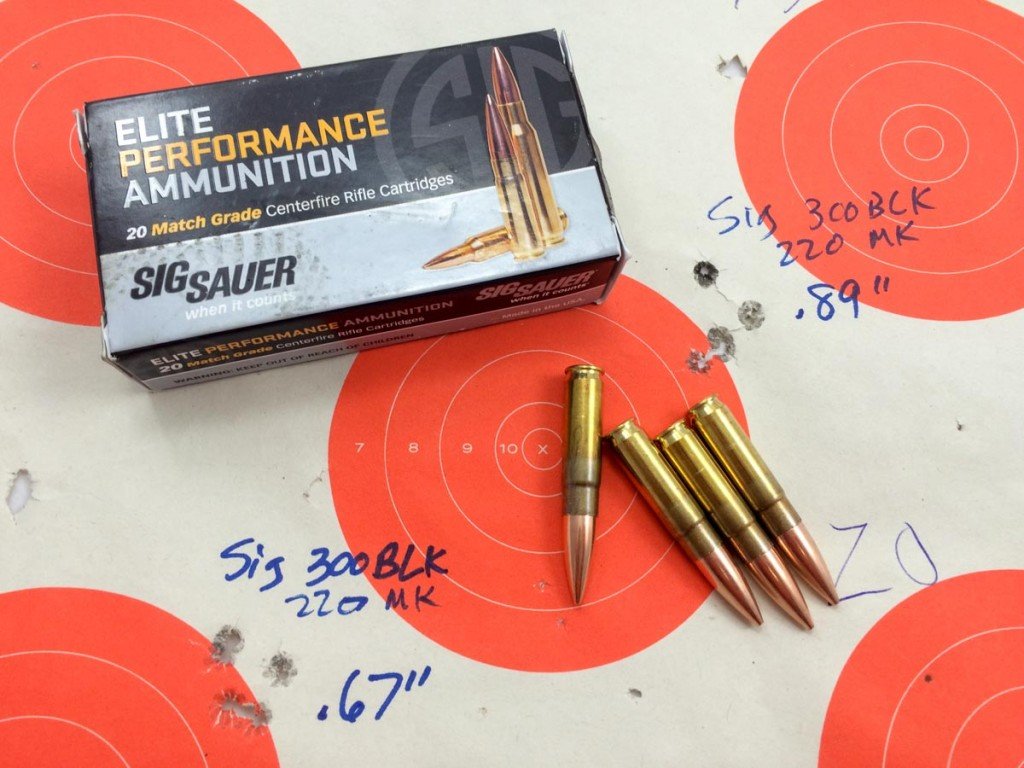
This load is nothing if not consistent. Here are a couple of the 5-shot groups from 50 yards using a Daniel Defense DDM4v5 300 Blackout rifle.
I also clocked this from a 300 Blackout pistol, in this case, a CMMG Mk 4. Again, given the intended nature of this setup, I used the same SilencerCo Specwar 762 suppressor. Until I got all excited from this subsonic fun and shot the screens off my chronograph, the Sig Sauer 220 grain subsonic load was averaging 888 feet per second from the CMMG pistol with its 10.5-inch barrel.
Accuracy of the round was impressive. Sig refers to this load as match grade ammunition, and the outstanding Sierra Matchking 220 grain projectile is used. Even still, a subsonic 300 blackout bullet flies like a high-speed brick, right on the verge of stability, so tight groups aren’t a given. I fired 5-shot groups with the Daniel Defense DDM4v5, which has proven exceptionally accurate with supersonic 300 AAC Blackout. I set up at 50 yards, which seems to be a very appropriate distance for the subsonic 300 Blackout. The best 5-shot group measured .67-inches while the worst was only .89-inches. From my experience shooting a wide variety of 300 Blackout subsonic ammo, that’s exceptional consistency.
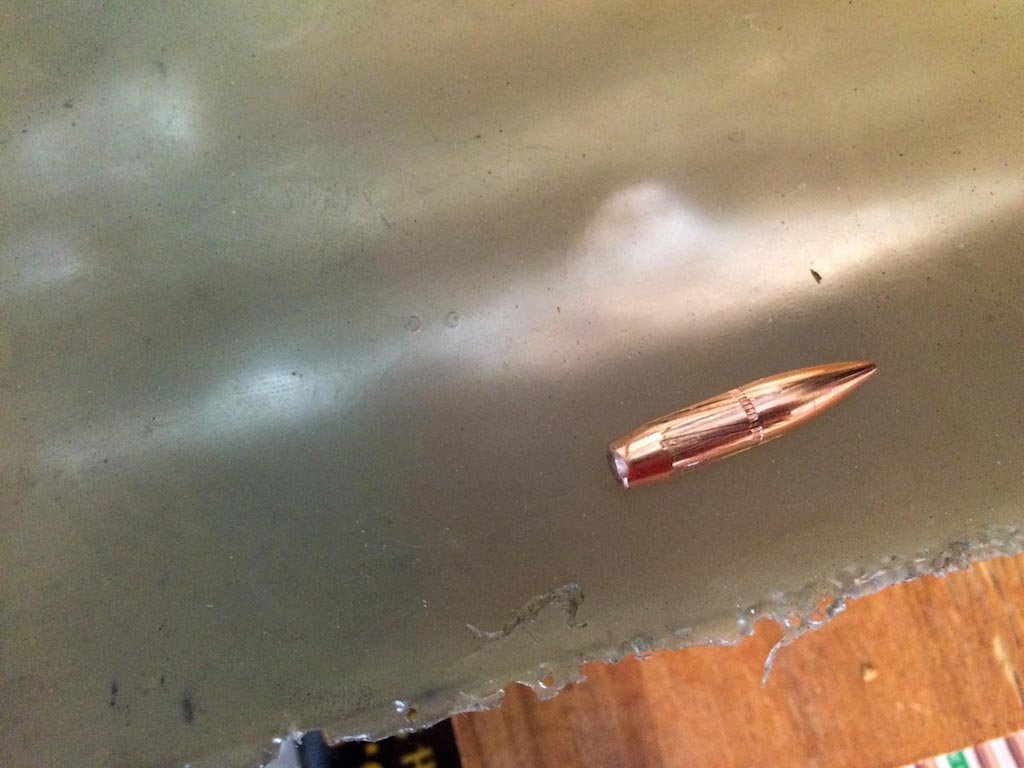
You just know I had to shoot these into gelatin blocks, right? As expected, the started tumbling almost immediately.
You just know I had to shoot these into gelatin blocks, right? As expected, the started tumbling almost immediately.
While it may sound silly to gel test this round as the Sierra Matchking projectile is not designed to expand, I did it anyway. The theory behind big, heavy, and unstable bullets is that they will immediately start tumbling end over end. What better way to find out than destroying a couple of Clear Ballistics gelatin blocks?
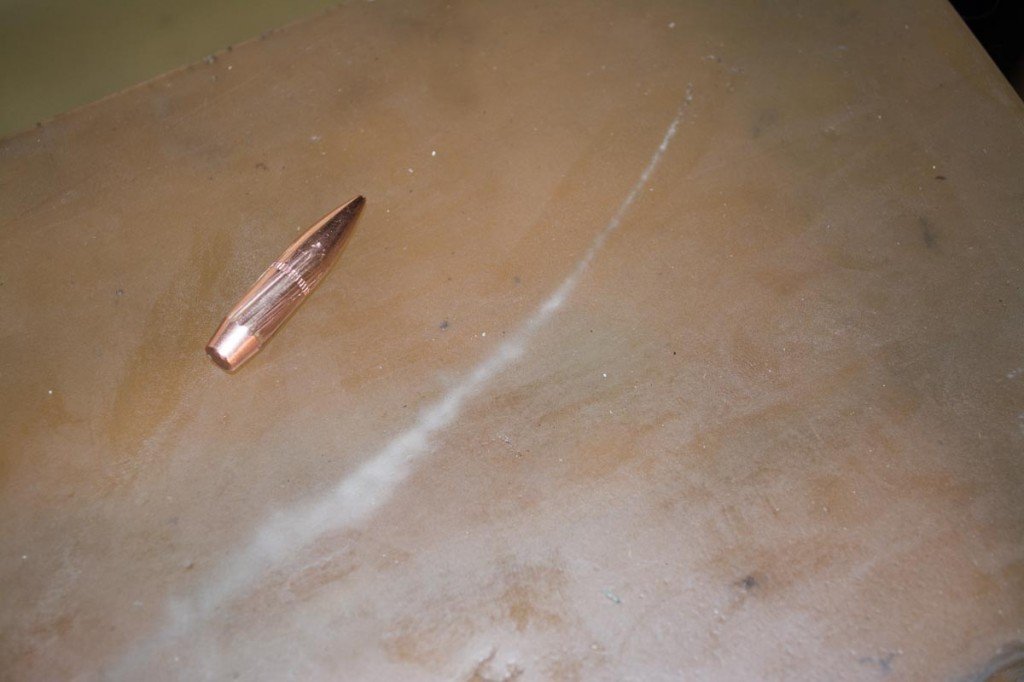
Once that big heavy projectile turned around backwards, it launched off in a wide arc, exiting the side of the gel block.
Well, the tumbling theory is correct. As you can see from the photos, the rumbling, tumbling big and heavy Sierra Matchking did a full rotation longitudinally about three inches into the gel. From that point, things got crazy and the bullet followed a curving path, ultimately exiting the gel completely from the side. Fortunately, I had a large backstop and was able to recover one of the projectiles. As you can see, it doesn’t expand (because it’s not supposed to) and it looks fairly pristine. Since the 1 ½-inch long bullet is tumbling end over end, I think the expansion concept is irrelevant in this case anyway.
You can find it for about twenty bucks a box online.
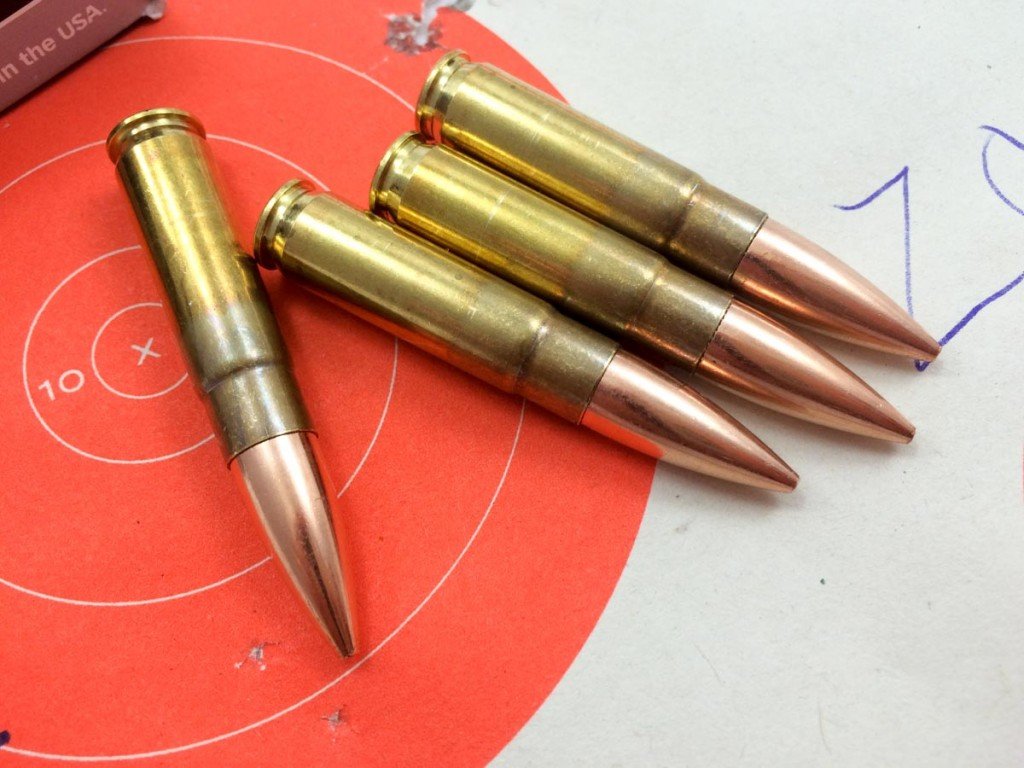
After trying the new sig subsonic, I have to agree that sig has a winner. It was quiter than many other the other top blackout ammo manufacturer’s. Still like the gemtec performance on deer size game and also black bear. Hope to get some in field use this year for the sig ammo. The sig ammo I have shot was extremely quiet with the aac snd-6 7.62can and printed some very nice groupings.
hooray for the young lady and her deer; now where is the best spot for shooting a hog to eat???
In the head! 🙂
I’m skeptical of the terminal effectiveness on game, particularly on tough feral hogs other than small size. At 1,000 fps there will be no expansion and at 488 foot pounds it is in pistol (hot 9MM, 40 S&W or hot 45ACP) round territory. Unless shot placement is precise, I don’t expect a reliable kill shot on large or tough game, at least not before it runs off.
I could be wrong, I haven’t fired one, but this sounds like round without a purpose for most folks. Maybe an AR home defense round when used with a suppressor; or if the accuracy is consistent, a close range predator round on the farm, or a close range urban tactical round, but I don’t see it as deer round or mid to long range tactical round.
I agree with you completely, and thank you for pointing out the 300 Blackout’s glaring downside: rifles chambered for it are reduced to putting out (+P) pistol-level energies. Used in its intended role (CQB fighting where very low audio-signature is a requirement), the .300 Blackout is a compromise that satisfies a specific goal. It was never meant as – and never will be – a good selection for hunting big game (at least in its subsonic varieties – like the one featured in this article). While your average gun counter idiot will point out that even a .22 can kill a white tail (or a bear, or a Mastadon…), using underpowered cartridges for hunting large animals neither ethical or compassionate. Articles like this propagate unrealistic performance expectations for this very underpowered cartridge and pitch the (subsonic) .300 Blackout as something it will never be. Thankfully, the reality is that this caliber simply the flavor of the day (another answer in search of a question), and look forward to it passing soon.
Dan,
Rob Silvers created .300 AAC/BLK to mirror 7.62 x 39 performance in an AR-15 type platform, and basically to standardize the .300 Whisper proprietary to SAAMI specs. In supersonic loads with a 125 gr bullet flying at ~2200 fps and ~1360 ft-lbs, it does just that very well out to 300-ish yards. It just so happens that, like the .300 Whisper, subsonic loads perform as a very quiet self-defense cartridge.
I’ve shot them unsuppressed, and it is easier to shoot than a .22 LR yet not much louder. This is very advantageous for many self-defense scenarios.
No one has ever implied that the .300 BLK was supposed to be a game killer in subsonic loads — I think it’s a little facetious to imply that is the role of this cartridge. 500 ft lbs is what it is. That’s about good enough for the ~200lb range level of living beings on this planet, human or otherwise.
I personally feel that the .300 BLK has some staying power for the reasons above, and also more-so because of the compatibility with 5.56 NATO AR Components, namely the bolt and the magazines. All it takes is a different barrel and all the other parts swap out.
Regardless of perceptions or bias one may have against the .300 BLK, these points are enough to make it very simple for a current AR-15 owner to try out the .300 BLK very cheaply to form their own opinion of the round.
One large negative has been that because demand for the round is so high across the private and government levels, supply of OEM ammunition is pretty tight. Unless that issue is settled pretty quick, that could be the one fly in the ointment that retards .300 BLK adoption.
The idea of a 110 gr bullet and 220 grain bullet our of the same gun sounds good to many sportsmen. The notation about ammo is this- you can make at home your own brass and use surplus USGI 147 gr projo’s – that’s darn cheap shooting for a 30 cal. Although half mile kills are the rage, us here in reality town shoot things 10 to 50 yards. We like to hunt and the skill of getting close is what turns our crank. We also hog hunt and the critters have learned to live in the most inhospitable environment just to avoid getting shot! The 300 is magic when shooting through brush as it DOES tumble and usually just before impact. The autopsy shows a inch and a half of wound channel throughout the hog and the preferred headshot rarely presents itself. The 300 AAC has its place in the AR platform but that is the cool part. The ar platform is a corucopia of calibers- one for every flavor.
I’d like to see Hornady 120gr SST 6.8spc
If you look back at some of the hog hunting stuff we have done here you will see that it is a devastating round and exceeds the box velocity. For the 6.8, it is THE round to stockpile.